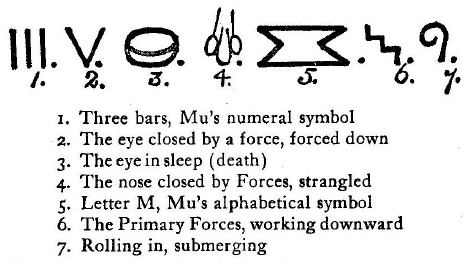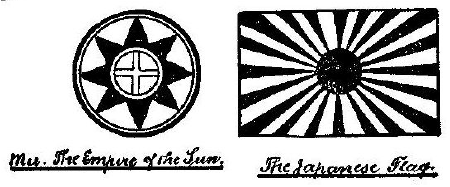|
CHAPTER XV
Two ancient gold masks found at Monte Alban near Oxaca were taken from an ancient tomb by Dr. Alphonso Caso recently. Monte Alban is not far from the pyramid Xochicalca.
The symbols on these two masks refer to the submersion and disappearance of Mu.
I give herewith the dissection and deciphering on the smaller one above (see Plate X).
This tells us the head symbolizes Mu, that her eyes are closed in
sleep, she no longer sees, that breathing has ceased because the
forces prevent her from breathing through her nose, and the letter M
covers her mouth.
These
masks are not so very old, probably contemporary with the earlier
life of the pyramid, which would be some time after Mu went down,
neither are they modern for they long antedate the Aztecs.
Traditions exist saying that some of the Malay Islands were peopled from the Motherland by a branch of the Quiche Mayas.
These colonists, after establishing themselves on these Malay Islands, for a cause untold left their Malay home en masse and migrated to some islands farther north where a new settlement was made. These colonists were the forefathers of the Japanese of today. On inquiry among the Japanese themselves I find these traditions accepted by them.
Their own traditions are a little different but agree on all material points.
When the Japanese arrived in Japan they were a highly civilized people, enjoying the culture they had retained from the Earth's First Great Civilization.
This they retained down to within the memory of living man.
Then they commenced to adopt the new civilization. Today they are modern in all respects and of high rank and standing among the most advanced people on earth, and all this change has been made by themselves during the past 50 or 60 years. If we could go back 100 years and look in on Japan we should see a reflection of Mu 15,000 years ago.
The Japanese flag today has been
brought down by them from the Motherland. It is a Sun, the emblem of Mu, the Empire of the Sun. Beyond their flag, the Japanese have
among themselves many of the ancient religious conceptions and
symbols of the Motherland. Various customs also connect them with
the First Civilization.
The
Japanese language today embodies fully 40 per cent of Quiche-Maya
words.
Ceylon is a small island lying close to Cape Comerin, the
southern point of the Hindu Peninsula. It is a very beautiful island
and has been called "the pearl on the brow of India."
The present Cingalese are undoubtedly from white
stock. They are not Aryans; lying between them and the Hindu Aryans
is a black race occupying the southern parts of India and called
Tamils. I have failed to find their language or anything like it
spoken anywhere in the Orient, the Malays or South Sea Islands.
Their language was fully developed and they were highly civilized
when they came to Ceylon only a couple of thousand years ago.
That they
are a branch of Naga Mayas I do not doubt for a moment because all
the names of their towns, rivers, etc., are pure Naga-Maya words.
They did not remain long in peace here for
the Tamils found them again, sacked the city and once more carried
off their young women. Then the Cingalese made another move and went
up into the heart of the mountains. Here the Tamils could not reach
them. They built a new city and called it Candee. Here they remained
in full possession of the mountainous part of the island until
Ceylon was occupied by the English.
They have a plain but unique temple at Kandy.
The ancient history of East Africa is a sealed book, the cover has never been opened.
If, however, all that is told by hunters and explorers be true here is an exceedingly rich field for the archaeologist. In India I found references to companies of Naga Mayas going to East Africa - some on the shores of the Red Sea, others farther south - but absolutely no details on which one could work.
When one looks back over the conditions at the time the Children of Mu were stretching themselves all over the world, it becomes
inconceivable that, when they struck the African Coast from India,
they should not have worked south as well as north.
The following is an example:
1 According to my map, Kilwa is just 200 miles south of Zanzibar, not 400. This difference lies between the map and the traveler. They have got to fight that out between themselves.
This description is one of three which I have come across, but not one mentions anything about the character of the fillings between the cities or, in fact, anything about the geological aspect.
The character of the fillings between buried cities is the most important point of all in arriving at a deduction as to the age of the cities and the cause of their destruction. I have found records of the Phoenicians trading along the East Coast of Africa. This shows that East Africa had a population. It is an exceedingly strange phenomenon that three ancient cities should so often be found lying one over the other in such widely separated parts of the earth.
This leads to the following question: were each of these
three civilizations contemporary with each other - America, Asia and
Africa? If so, being so widely separated from one another, did the
earth in these past ages undergo three great convulsions that each
time virtually destroyed the greater part of mankind?
I have given them for what they are worth.
Authorities are not all in accord as to the origin of the New Zealand aborigines - the Maoris.
My personal conclusions are that New Zealand was one of Mu's small distant colonies, a separate and independent line. New Zealand lay about a thousand miles south of the southwest corner of the Motherland, a distance not insurmountable when we recollect that the ships of the Motherland,
In all probability the settlers in this distant New Zealand would have been, comparatively speaking, few in numbers but of the best and most enterprising type.
Being few in numbers they would naturally devote themselves to the tilling of the soil rather than to the arts and sciences and manufacture. They would naturally, like colonists of today, draw their manufactured supplies from the Mother Country. When the Motherland was destroyed and submerged, the New Zealanders, not being skilled artisans but tillers of the soil, were unable to manufacture such supplies as they had been obtaining from the Mother Country, so they were compelled to fall back on primitive methods.
New Zealand, being a large area of land with great natural
resources, could offer these colonists within their settlement the
wherewithal to get along, so that this colony of Maoris did not fall
quite as low as did many of the poor remnants left upon the jagged
rocks of the Pacific Ocean.
O'Brien tells us that the classic language of Polynesia today is the Maori tongue. He advances the theory that the Maoris came to New Zealand from the Polynesian Islands, whither they had come from Asia. I feel that he is wrong in both cases. As before stated, there are many evidences showing that the Maoris went to New Zealand before the submersion of Mu.
I base these deductions on the following:
The natural inference from these facts is: the Maoris came
direct from the Motherland to New Zealand.
I have been unable to trace Heawice or to connect it with any of the South Sea Islands or the Malays. Heawice may, therefore, have been the name of that part of the Motherland from whence they came.
Personally, I have been unable to find out anything from them beyond what Captain Cook relates - they came from Heawice.
This might simply have been symbols of the various attributes of the Deity which Captain Cook would not have understood.
The Maoris of New Zealand, the descendants of the white race of the Motherland, have weathered the storm magnificently.
They have passed through the fires of adversity, trials and tribulations, and have come out of them worthy of the grand old race from which they sprung. With the disappearance of their Motherland from whence came their necessary supplies, everything was lost to them except their bare homes and land. This great loss was no fault of theirs, only their misfortune.
Notwithstanding this staggering blow, thousands
upon thousands of years have been insufficient entirely to eliminate
all of their original civilization. Their brains and the better
parts of their nature have remained for, with the new civilization
taught them by the English and the opportunity given them, the
Maoris have made unprecedented strides in learning and in regaining
their place among the most enlightened and civilized people on
earth.
Today, the children of these savages are many of them highly educated, filling positions in the professions and in the government of New Zealand. England is proud to reckon the Maoris among her family of children, for under her tuition their advancement has made gigantic strides. The springing forth of the Maori into the bright light of the New Civilization has not been a step in evolution or even a development.
His development took place in the Motherland
eons of time ago. His great leaps and bounds in enlightenment and
learning are simply due to the freeing of his brains from thousands
upon thousands of years of imprisonment. It has been an awakening
from a long, long sleep.
A savage can only rise above his
savagery when he is taught to do so by civilization. When the savage
is left alone, civilization does not meet him. Then he constantly
falls lower and lower.
The Maori traditions are many "and very interesting. Among
them is the story of "Cain and Abel."
|

